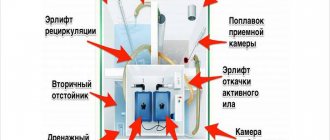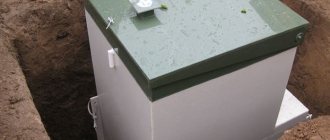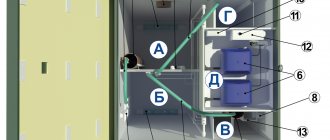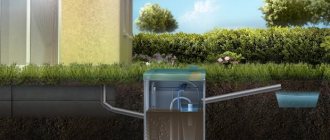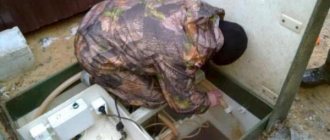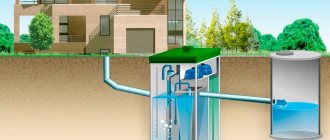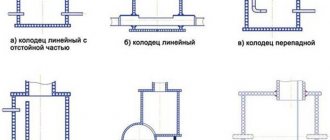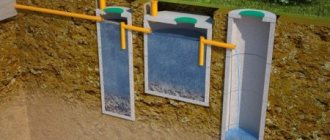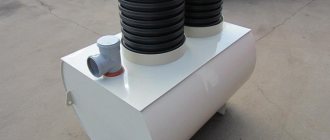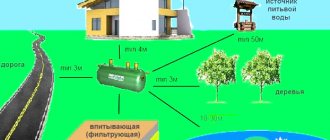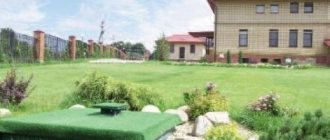Preparation for installation
Topas brand devices are models of autonomous sewage systems, in which the full cycle of wastewater treatment occurs inside the structure. It is allowed to install a Topas septic tank in a country house or in a house where the owners either live permanently or visit periodically. The peculiarity of the design is that waste water is constantly required for its operation. After all, for bacteria living in a bioreactor, biological waste is the main food; without it, living organisms simply will not survive and work will be completely disrupted.
Before installing Topas septic tanks, you should consider the type of soil. Models with a gravity drainage type are installed only in loose soil, where the main components are black soil and sand. For clayey and rocky soils, the use of models with gravity flow is impractical, because water simply will not drain into dense soil. Therefore, in such soils, devices with forced water drainage are used. The main feature of such septic tanks is the presence of a drainage pump and a special compartment for collecting the resulting liquid. This water can be reused for household needs, which is very convenient and economical.
Options for organizing wastewater disposal
By gravity into the drainage well
By gravity into the storage tank
Into the intermediate well
With a UV block in a pond
The choice of location for installing a Topas septic tank should be approached very carefully. The position of the station is determined in compliance with sanitary standards. First of all, customers should contact the SES and obtain permission for installation on site, since the product is potentially dangerous and can cause damage to the environment.
The corresponding design document is submitted to the SES, according to which the possibility of installing the product on the site and compliance with all rules and regulations is assessed. So, the structure is installed at a distance of at least 50 meters. It is allowed to install a Topas septic tank at a distance of at least 30 meters from any open water source, for example, a river, lake or reservoir. The station must be located away from trees and bushes at a distance of at least 3 meters, and the distance from the foundation of the house to the product must be at least 50 meters.
Design and principle of operation
This autonomous treatment station is internally divided into four compartments, each of which has its own cleaning stage. The wastewater sequentially goes through all four stages of purification; at the end, as the manufacturer says, the degree of purification is 98%. Waste processing occurs with the help of aerobic bacteria that live in the presence of oxygen. To ensure their vital functions, each compartment has aerators that pump air.
Topas septic tank installation
The Topas septic tank works according to the following principle:
- The wastewater enters the receiving chamber, where it begins to be processed by bacteria. While filling is in progress, air is supplied to the chamber to activate bacterial activity. During the process, insoluble particles settle to the bottom, while fat-containing particles rise to the surface. In this compartment there is a filter for large fractions - this is a large diameter pipe in which holes are made. There is a pump installed inside this pipe that pumps the water that has passed through the filter. Thus, the drainage enters the next compartment without large contaminants - they remain in the receiver and bacteria continue to process them. At this stage, the wastewater is purified by approximately 45-50%.
- From the receiving chamber, partially purified water is pumped into the second compartment - the aeration tank. When filling, aeration switches here, which allows you to raise pollution particles above the surface of the water. Since the shape of the chamber is pyramidal, they settle quickly. About 20-30% of contaminants still remain in this compartment. With the help of pumps and special airlifts, semi-purified wastewater enters the third chamber, and excess sludge from the bottom is pumped into the stabilizer chamber.
- The third and fourth chambers are similar in structure to the second. Here, according to the same principle, the final purification of wastewater occurs.
- Clarified water from the last compartment, by gravity or using pumps, is directed into the ground, into a container where water is stored for technical use, into a filtration column, etc.
As you understand, the entire operation of the Topas septic tank is based on the activity of bacteria. They require certain conditions - the presence of oxygen, positive temperature. Aerators supply bacteria with oxygen, so it is very important to provide the installation with continuous power supply. After turning off the power, bacteria can survive for 4-8 hours. If the air supply is not restored during this time, the installation will have to be populated with new ones.
The process of digging a pit
To install a Topas septic tank, a pit is required. But before digging it, experts take into account several important factors, namely:
- soil type;
- climatic features of the region;
- depth of soil freezing in the cold season;
- installation depth of conductive pipes;
- sewerage model chosen by the customer for installation;
- the amount of wastewater processed by the septic tank per day;
- groundwater position.
There are also several methods for obtaining a pit, and the choice of each of them depends on the characteristics of the site and the location of buildings and plantings on it. The pit can be dug manually or using special equipment. Of course, using technology is the preferable option, because in this case it is possible to obtain greater accuracy, and most importantly, get the job done much faster. However, the cost of installing a Topas septic tank in this case is higher.
Experts calculate the parameters of the future pit, taking into account the dimensions of the septic tank, the presence of a concrete pad and the cover of the product, and determine its width and height. After determining the dimensions of the pit, a place to dig a trench is selected, its depth and angle of inclination are taken into account. In the case of clay soil, the creation of a pit has its own characteristics, because clay soil can absorb only 25 liters of water per day, while the absorption capacity of sandy soil is 90 liters per day. Taking this feature into account, engineers propose concreting the bottom of the pit and making a separate container or well to receive the resulting water. It is also known that clay is capable of changing its structure during cycles of freezing and thawing, and can simply move the septic tank from its installation site. Therefore, when installing the purifier in this type of soil, steel cables, loops, protrusions, etc. are used.
Quicksand is considered one of the most difficult types of soil. This is a type of soil that is saturated with water. In its properties, it resembles a clay type of soil, however, digging a pit and installing a septic tank in such soil is much more difficult. While digging a pit, specialists periodically pump out the water accumulated at the bottom. After the process is completed, workers install the formwork. For this purpose, boards and beams are used. They are installed along the entire perimeter of the pit as closely as possible to each other. Installation of the Topas septic tank is carried out as if in a frame built from boards; in this case, the creation of a cement pad is not required.
How to properly install and connect the Topas station
Despite its apparent simplicity and clear operating principle, the Topas installation requires compliance with a number of conditions that guarantee stable and high-quality water purification:
- It is recommended to install and connect local treatment facilities “Topas” no closer than five meters to residential premises and places where people are located. Despite the absence of high-pressure pipes and containers in the device, it proposes to take measures to prevent the consequences of the release of contaminated and biologically unsafe liquid;
- The standard installation scheme involves placing the Topas septic tank in a prepared pit in the ground according to the diagram shown in the figure. On the opposite walls of the Topas installation there are receiving flanges to which sewerage pipes and purified water discharge are connected;
- The most serious attention should be paid to the power supply to the septic tank installation and the arrangement of a grounding system in accordance with the requirements and operating instructions for the unit.
Advice! If you do not have the appropriate experience in connecting electrical wiring, entrust the repair of the power supply and compressor part of the Topas installation to specialized specialists.
The process of laying a sewer line
To equip highways and connect the septic tank to the sewer system of the house, pipes for external work are used from materials such as plastic, asbestos cement, cast iron, and steel. Currently, experts prefer plastic pipes. This is because they are strong and durable, able to withstand heavy loads, and do not deform under mechanical stress.
A feature of pipes for external sewerage is the lack of supporting internal pressure, therefore, during installation, the pipe walls are strengthened by compacting the soil. Some customers require the installation of pipes to the depth of soil freezing and below, however, the operating features of the septic tank allow the pipes to be left at a level of at least 60 cm from the surface. Even under these conditions, freezing is not observed; in some conditions, additional insulation is created.
Pipes are installed at different slopes depending on their diameter. A pipe with a diameter of 110 cm has a slope of 2 cm for each meter of the product. A pipe with a diameter of 160 cm is most often located at a slope of 1.5 cm per 1 meter.
The electrical cable is laid in the same trench as the main main pipe. In order to keep the cable unharmed, it is laid in a HDPE pipe with a diameter of 25 mm, but other types of pipes can also be used.
Depth of the supply pipe for various Topas models
To properly arrange a drainage system for water from a septic tank, you must also take into account the type of soil, special requirements, and the presence of buildings and other objects on the site. For a certain type of soil and in the case of high groundwater level, purified water is discharged into any containers, wells, ditches. The drainage pipe is installed without sagging, its length ideally does not exceed 10 meters.
To drain wastewater by gravity, you will have to install a drainage well. The problem with such a drainage is that the drainage becomes silted over time. It must be removed and the gravel bed replaced once every 5-8 years. However, this method has many advantages and advantages: the water in the ground does not freeze and remains within the site, and the cost of the septic tank is reduced by the cost of the drainage pump.
For large areas, a storm drain is used. The drainage pump does not have enough power to pump water over long distances, so in this case, a sealed reservoir is installed at some distance from the station, and when it is filled, the water is pumped into the ditch.
Completion of installation of the Topas septic tank, connection of equipment
An important condition for the correct, and most importantly environmentally friendly, operation of the station is its tightness. Since the septic tank itself is a tank cast from polymer and without seams, leaks most often occur in places where sewer pipes join each other or where they are inserted into the body. Most often, PVC pipes are used for autonomous sewers; they do not have joints and are simply inserted into one another using technical Vaseline. The use of mineral oils and other types of lubricants is unacceptable. The body of autonomous sewers often has special couplings for connecting the sewer pipe to the device itself. However, before connecting the pipes, specialists will equip a wooden box in order to reduce the load at the connection point. The pipe for removing purified water from the septic tank is installed in the same way, and it is also placed at a slope if gravity removal of water is expected. With or without any slope, if a pump is used to remove purified water.
The compressor is considered one of the most important parts of the purifier design. In all models, it is installed in the septic tank, in the upper part of the device on a special shelf. Thus, it does not take up space and is completely weatherproof. There is a special hole in the cover to connect the electrical cable. Another outlet provides oxygen flow to the compressor. The compressor chamber is protected from getting wet and insulated. In some models, the pump is installed inside a special chamber. During installation, it is firmly fixed. When suspending a stationary pump, a pipe with a diameter of 32 mm is used; the pipe entrance to the tank is equipped with a threaded bend. The pipe insertion site is sealed. The cable is securely fixed with plastic clamps. The side walls are used for cable exit.
A septic tank is permanently connected to the network only when aerators or equipment are installed inside the chambers to ensure the movement of drainage between the compartments.
After completing the connection of all devices, the system is launched for the first time and all possible parameters are debugged. Workers regulate the power of aerators and prepare control units for operation, if any in the structure. They are located at the top of the purifier and are accessible through the lid. The cable on the surface is also insulated from moisture and mechanical stress. The cable exit points are insulated with a flexible coupling. Only after a trial run and complete completion of the entire cycle of work on laying the cable along the site, as well as filling the trenches, is the cable connected to the home network.
Septic tank maintenance - mandatory procedures
Maintenance should be carried out 1-4 times a year (cleaning up excess sludge, not necessarily calling a specialist). It is necessary to remove foreign objects from the first compartment that organisms cannot process.
Cleaning filters and airlifts
Cleaning instructions:
- power outage;
- stopping the air supply by disconnecting the hose from the body, do the same with the pumps;
- washing filters with water, preferably under pressure;
- cleaning the air purifier nozzles with a needle or similar sharp object;
- reassembling the structure, filling it with water to the required level (for correct operation), starting the septic tank.
Removing excess sludge
If the sludge that enters the stabilizer chamber is not cleaned at least once every three months, it will begin to flow back into the first compartment and the water will become even dirtier due to stagnant sludge.
You should:
- turn off the power supply;
- prepare rubber gloves and a bucket;
- open the plug and, placing the hose in the chamber and bucket at the same time, start the pump (you can use a fecal pump), the sludge and waste will be completely pumped out;
- After the pumping process, fill the chamber with clean water and close the plug.
Conservation
If you plan to live in the house only in the summer, mandatory conservation of the Topas septic tank for the winter is required. It is required to ensure that the bacteria contained in the compartments do not freeze. If they start to freeze, they will inevitably die. You should not carry out preservation immediately before the onset of frost; it is better to do it in advance in the fall.
- The hatch is insulated using polystyrene foam or mineral wool;
- do not drain water from all compartments, clean them of debris;
- all necessary parts that are involved in the cleaning process are disassembled, dried, cleaned and stored in a dry, ventilated room.
These measures will help to effectively preserve the septic tank so that microorganisms go into suspended animation until next summer.
Why is it important to contact specialists?
As can be seen from everything described above, installation of Topas septic tanks is a complex, labor-intensive job that requires appropriate knowledge, level of training and significant experience. Today, thanks to the presence of social networks, various thematic blogs and videos in them, many buyers try to do even complex work on their own. However, as practice shows, in most cases, a home-made installation contains many errors and often becomes the main cause of sewage failure.
To avoid huge financial costs, fines and other problems, we suggest you contact specialists. Our company has been installing Topas septic tanks for a long time, so we have well-established work schemes, all the necessary equipment and a precise understanding of each stage of installation. With us you will receive a ready-to-use cleaner in the shortest possible time. We always take into account all the wishes of the customer, treat each project with great attention and carry out the work with great care.
After contacting us, our employees visit the site, help you choose a septic tank if necessary, and then formulate possible engineering solutions and provide them to the customer. The optimal installation option for the product is determined jointly. During their work, employees use components from proven, reliable manufacturers. The arsenal includes pipes, couplings, adapters, drains, sealants, and insulation materials only from well-known European and Japanese companies. Our clients can buy a Topas septic tank with installation.
The presence of all the necessary components, a clear work plan and constant cooperation with the customer helps us carry out installation at any site in a short time and at the most favorable price for the customer.
Maintenance Features
Septic tank Topas is a reliable, highly efficient cleaning station. It is capable of working for a long time and efficiently processing wastewater. Its maintenance, contrary to expectations, is simple; it consists of periodic inspection, periodic pumping out of excess sludge, and removal of particles that cannot be processed.
The best solution when organizing service is to contact specialized service centers to create all the necessary conditions for carrying out work of any degree of complexity, high-quality and inexpensive maintenance of septic tanks.
